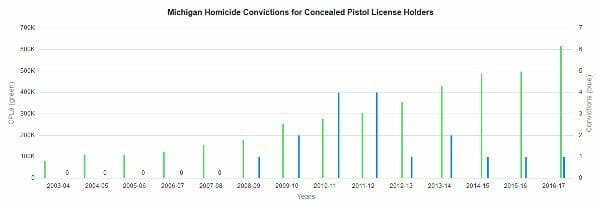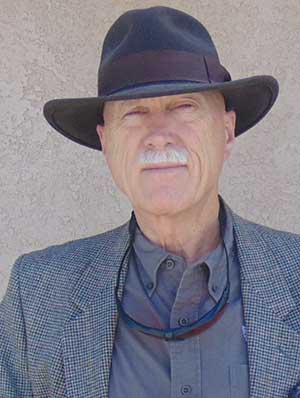
Arizona -(Ammoland.com)- Michigan Concealed Pistol License holders have an extremely low murder rate. Japan has a very low murder rate. Japan is also a very law-abiding culture.
The United States, as a whole, has a much higher murder rate than Japan. Within the United States, there is a law abiding culture that has a murder rate as low as Japan’s. That culture consists of gun owners who carry guns legally.
The FBI generally includes legally defined murder, which may be in the first or second degree, and non-negligent manslaughter, in the definition of murder for their statistics. A more precise definition might be “criminal homicide”.
In Michigan, the State Police are tasked with compiling crimes committed by people who have the Michigan Concealed Pistol License (CPL). The State Police Reports are available from 2003 to early 2017. The state police report list convictions of people for murder, and manslaughter, as well as a multitude of other offenses. From 2003 to 2017, there are 14 years of reports listing criminal convictions.

Criminal homicides are the most reliable crime statistics to track, and the most important for comparisons with other societies. While there are significant differences in definitions, reporting, and recording of crimes from nation to nation, murders, or criminal homicides, are more reliable than other crime statistics.
In the 14 years of Michigan annual police reports, there are 17 criminal homicide convictions recorded by the Michigan State Police (MSP), for people who had CPLs.
The number of active CPLs in Michigan for each year of the 14 annual reports was a little more difficult to find. The annual reports run from October 1 to September 30 of the following year. I found numbers in each annual report period, except for the period of October 1, 2014, to September 30 of 2015. For that period I interpolated from the March 2014 number of 430,000 to the November 2015 number of 488,000, to obtain 459,000. The numbers for the other years used were within the period for each report. Over the fourteen year span, a variation of a few months does not make much difference.
When looking at criminal homicide rates, the standard is to look at the number of homicides per 100,000 of the population per year. The total number of CPL – years came to 3,953,944. Over the 14 year period, individual CPLs had been active for a total of 3,953,944 years. There were 17 criminal homicide convictions of CPL holders in that period, averaging .43 criminal homicides per 100,000 CPL holders per year.
The entire Michigan population, over the same period, had an average of 6.2 criminal homicides per 100,000 people, or more than 14 times as many. Over the same period 2003-2016, the Japanese criminal homicide rate was .42 per 100,000 population.
Michigan Concealed Pistol Licenses are fairly easy to obtain. The same background check is used for the CPL as is used for ordinary people to buy from federally licensed dealers in the United States. The people with Concealed Pistol Licenses are not only able to own firearms but to legally carry them concealed and loaded with them nearly everywhere.
Yet, their criminal homicide rate is as low as the highly regulated Japanese.
International comparisons are always tricky. Many countries do not keep good statistics. Some countries actively ignore some murders to make their statistics look better. Others do not have the infrastructure to report and record crimes. Countries have different definitions of what a criminal homicide is.
In cases such as Michigan, the numbers of homicides among Concealed Pistol License holders is so tiny that it can vary enormously with just a few crimes. Fourteen years gives us a better picture, but it is still a small sample. There are five years with no convictions, five years with one conviction, two years with two convictions and two years with four convictions. The convictions do not mean the CPL holder used the CPL in the crime. They mean there was a criminal homicide conviction for someone with a CPL.
While not as well documented as the Michigan CPL, the Wisconsin CCW permit holders have a similarly low rate of criminal homicides. When I calculated the number in 2016, the criminal homicide rate for CCW permit holders in Wisconsin was .19 per 100,000. Wisconsin CCW permits are easier and cheaper to obtain than Michigan CPLs.
If, as those who wish a disarmed population claim, the mere presence of firearms makes criminal homicide more likely. How is it that those who not only own handguns but can legally carry them loaded most places, most of the time, have a criminal homicide rate as low as the Japanese?
The law abiding American gun culture is as responsible and law-abiding as Japanese culture.
Japanese culture is much more homogeneous than American culture. American culture has a wide diversity. Some subgroups, like American legal gun carriers, are very law abiding and responsible. Other American sub-groups are not. American culture is closer to an amalgam of world culture.
The world average intentional homicide rate was about 6.2 per 100,000 in 2012, very close to the average Michigan homicide rate over 2003 to 2016. The U.S. criminal homicide rate for the same year was 4.7. There are differences between “intentional homicide rate” and “criminal homicide rate”. The numbers show the U.S. to be on the low side of the average world rate.
If someone tells you that legal American gun owners are not murderers until they are, tell them that Japanese, without guns, are as likely to murder as legal American gun owners.
Where crimes of people with carry permits are documented, that population has extremely low crime rates. Crime rates as low as the populations of those countries with the lowest crime rates in the world.
©2018 by Dean Weingarten: Permission to share is granted when this notice is included.
About Dean Weingarten
Dean Weingarten has been a peace officer, a military officer, was on the University of Wisconsin Pistol Team for four years, and was first certified to teach firearms safety in 1973. He taught the Arizona concealed carry course for fifteen years until the goal of constitutional carry was attained. He has degrees in meteorology and mining engineering, and recently retired from the Department of Defense after a 30 year career in Army Research, Development, Testing, and Evaluation.
